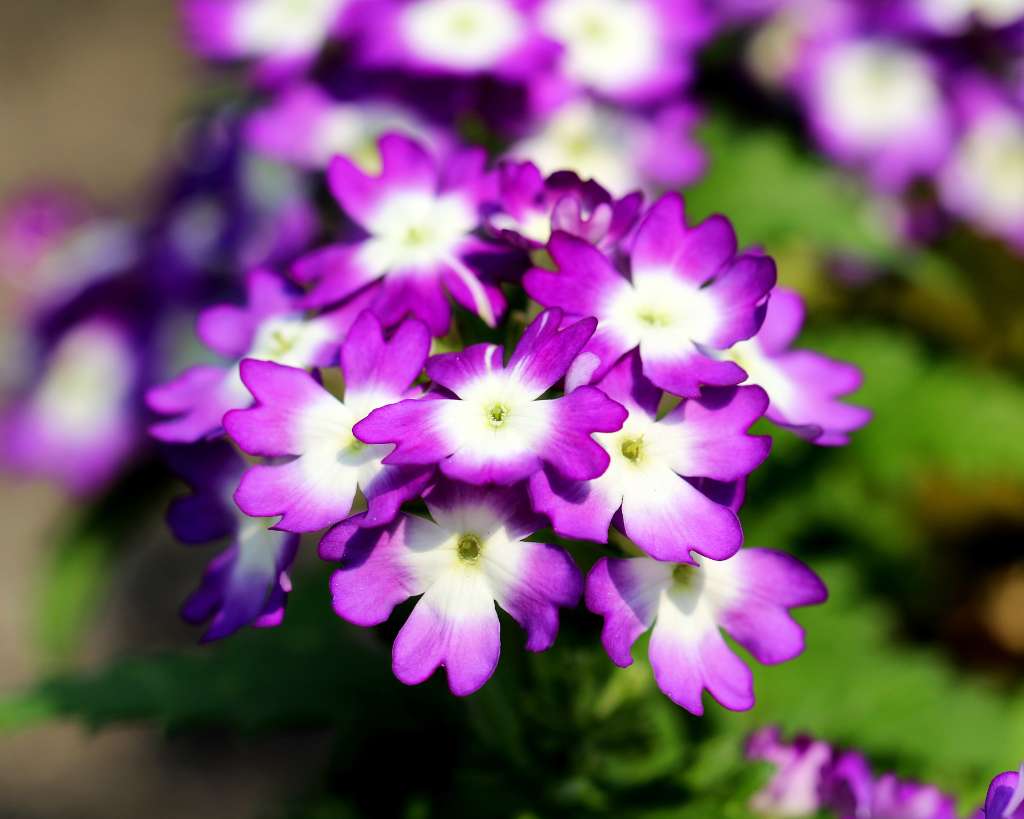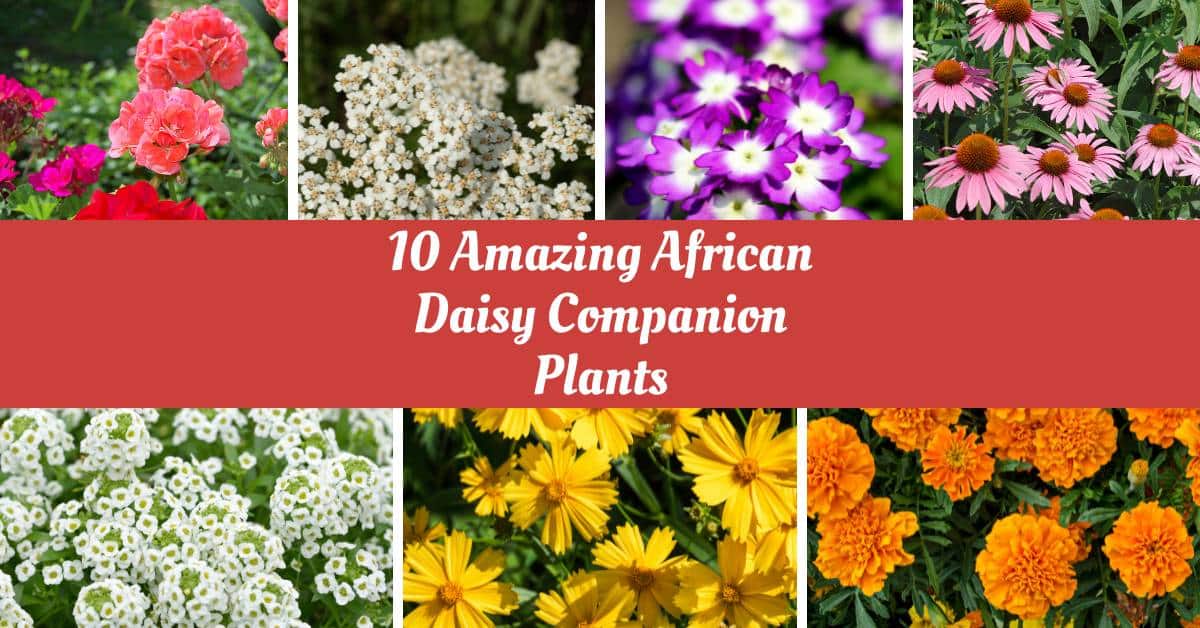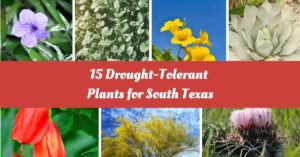Gardeners love African daisies (Osteospermum spp.) for their beautiful flowers, impressive blooming period, and versatility in landscape settings. Its fragrant blooms can attract pollinators, and its drought-tolerant nature makes it one of the easiest plants to grow in your garden.
Now, you might be thinking about the plants you can plant with it to enhance the appeal of your garden.
Fortunately, the African daisy has numerous plants with the same preferences and growing requirements. Whether you are creating mixed borders or a Mediterranean-themed garden, African daisies will complement any design when grown next to specific plants.
Let’s dive deep into the 15 African daisy companion plants and how to grow them.
Characteristics of African Daisy Companions
When choosing the plants to grow alongside African daisies, you must consider certain traits that will benefit both plants. For example, due to their similar growing habits, lavender, verbena, and yarrow grow extremely well when paired alongside African daisies.
African daisy thrives under the conditions given below:
- Annual, Perennial
- Well-drained moist soil
- Slightly acidic to neutral pH range of 6.0 to 7.0
- Full sunlight
- Drought-resistant
- Heat-resistant
An African daisy companion can be fruitful if it ticks the above boxes. There are other things that you may consider which will enhance the overall look of your garden.
Best African Daisy Companion Plants
1. Marigolds

- Scientific Name: Tagetes spp.
- USDA Hardiness Zones: Varies depending on the species, but generally 8-11.
- Plant Type: Herb / Annual or Perennial (depends on the species)
- Flower Colors: Yellow, orange, or red (not pink)
- Flowering Season(s): Summer, Autumn
- Plant Size: Depending on the species, but typically 6 inches to 3 feet tall.
If you’ve just started gardening, growing marigolds can be a good option. Marigolds are versatile, and they can easily acclimatize in varying climatic conditions.
Both African daisies and marigolds share similar preferences regarding growing conditions. Both plants thrive in full sun and well-drained soil, making them compatible companions regarding light and moisture requirements.
Marigolds can deter obnoxious pests such as nematodes known to damage or feed on the daisies. Marigolds are available in various vibrant shades, including yellow, orange, and burgundy. For example, pairing orange marigolds with purple African daisies creates a striking complementary color scheme.
Pair them together in a lower border or foreground in a garden bed to create a visually pleasing height and textural contrast.
2. Lavender

- Scientific Name: Lavandula spp.
- USDA Hardiness Zones: Varies depending on the species, but generally 5-9.
- Plant Type: Herb / Perennial
- Flower Colors: Lavender, purple, or white (not pink)
- Flowering Season(s): Summer
- Plant Size: Varies depending on the species, but typically 1 to 3 feet tall.
Lavender is known for its delightful fragrance, which adds an aromatic element to the garden. When paired with African daisies, the garden becomes visually appealing and provides a sensory experience with the sweet scent of lavender mingling with the daisy blooms.
Not only the fragrance combining both plants will enhance your garden’s visual appeal as well. Lavender’s beautiful purple blooms complement the various colors of African daisies, such as pinks, whites, and purples.
Both plants share the same growing preferences, and they are known to attract pollinators as well.
Depending on your climate, African daisies and lavender may require winter protection. In colder regions, African daisies are often treated as annuals, while lavender may benefit from mulching around the base to protect the roots from freezing temperatures.
3. Lamb’s Ear

- Scientific Name: Stachys byzantina
- USDA Hardiness Zones: 4-8
- Plant Type: Herb / Perennial
- Flower Colors: Pink or purple (as well as silver-gray foliage)
- Flowering Season(s): Summer
- Plant Size: Approximately 1 to 2 feet tall
If you love plant combinations that add contrasting textures to your garden, look no further than planting lamb’s ear with African daisies. Lamb’s ear has soft, velvety, silver-gray leaves that contrast the smooth, glossy foliage of African daisies.
Lamb’s ear has a low-growing habit, forming dense clumps near the ground. This makes it an excellent choice for creating a border or edging around African daisies, which often have a more upright or mounding growth habit.
African daisy’s blooms come in wide-ranging colors, such as purples, pinks, and whites. These colors complement the silver-gray foliage of the lamb’s ear well, thus creating an eye-catching combination that adds depth and dimension to the garden.
4. Salvia

- Scientific Name: Salvia spp.
- USDA Hardiness Zones: Varies depending on the species, but generally 4-11.
- Plant Type: Herb / Perennial
- Flower Colors: Various colors, including pink.
- Flowering Season(s): Summer, Autumn
- Plant Size: Varies depending on the species, but typically 1 to 4 feet tall.
This perennial herb has an upright or spiky growth habit, which contrasts well with African daisies’ mounding or spreading form. The varying heights and structures of the plants create visual layers and add architectural appeal to the garden bed.
Both Salvia and African daisies are highly attractive to pollinators, including bees, butterflies, and hummingbirds. You don’t have to worry about the growing requirements because both plants grow easily without fuss in similar conditions.
You can choose different salvia varieties such as Salvia nemorosa (Meadow Sage), Salvia officinalis (Common Sage), and Salvia guaranitica (Anise-scented Sage) to plant alongside African daisies.
5. Coreopsis

- Scientific Name: Coreopsis spp.
- USDA Hardiness Zones: Varies depending on the species, but generally 3-9.
- Plant Type: Herb / Perennial
- Flower Colors: Yellow (some species have pink varieties, but predominantly yellow)
- Flowering Season(s): Summer, Autumn
- Plant Size: Varies depending on the species, but typically 1 to 3 feet tall.
Coreopsis, commonly known as tickseed, produces daisy-like drought-tolerant yellow flowers that complement the beautiful flowers of African daisies extremely well. Combining these two plants creates a classic and tropical look perfect for any garden theme. The tall stems of the African daisy contrast with coreopsis’ low-growing, bushy nature.
Both plants can grow in similar climatic conditions very easily. Both plants’ vibrant blooms are known for their extended blooming periods, providing a long season of color and interest in the garden.
Pollinators love to gather around coreopsis, which makes it more beneficial to have it as a neighbor for your African daisies.
6. Alyssum

- Scientific Name: Lobularia maritima
- USDA Hardiness Zones: 5-9
- Plant Type: Herb / Annual or Perennial (depends on the species)
- Flower Colors: White, purple, or pink
- Flowering Season(s): Summer, Autumn
- Plant Size: Approximately 6 to 12 inches tall.
Alyssum is a beautiful European native plant with tiny clustered flowers that blend beautifully with the flowers of African daisies. Not only the blooms of Alyssum are visually appealing, but it is also renowned for its sweet, honey-like fragrance.
Planting it alongside African daisies enhances the sensory experience in the garden as the scent wafts through the air. Combining visual beauty and delightful fragrance creates a truly enchanting garden environment.
In Europe in the 16th century, Alyssum was often found to be bordering gardens. Its low-growing habit spreading growth habit is ideal for planting it as a ground cover or edging plant, complementing the mounding or spreading form of African daisies.
Alyssum and African daisies are versatile plants grown in containers, hanging baskets, or directly in the ground.
7. Echinacea

- Scientific Name: Echinacea purpurea
- USDA Hardiness Zones: 3-9
- Plant Type: Herb / Perennial
- Flower Colors: Purple or pink (as well as white and other variations)
- Flowering Season(s): Summer, Autumn
- Plant Size: Approximately 2 to 5 feet tall.
This wildflower perennial has cone-shaped flowers that are adored by gardeners all over the world. To create an attention-grabbing garden, consider planting Echinacea with African daisies.
One benefit of planting them together is that both plants have relatively long blooming periods, ensuring continuous color and visual interest in the garden.
Both are pollinator friendly and grow very easily without any special care.
Also, Echinacea has a deep taproot system that benefits African daisies by enhancing soil drainage, aeration, and nutrient availability.
8. Verbena

- Scientific Name: Verbena spp.
- USDA Hardiness Zones: Varies depending on the species, but generally 6-11.
- Plant Type: Herb / Perennial or Annual (depends on the species)
- Flower Colors: Various colors, including pink.
- Flowering Season(s): Summer, Autumn
- Plant Size: Depending on the species, but typically 6 inches to 3 feet tall.
Verbena is a gardener’s delight because of its easy-to-grow nature and versatility. Its beautiful purple-colored flowers are a sight to behold. When planted with African daisies, the colorful blooms of both plants create an eye-catching display in the garden.
Verbena, just like African daisies, has longer blooming periods. When planted side by side, they create an extended season of floral beauty in the garden.
Verbena and African daisies’ contrasting heights and textures create an appealing visual contrast. The cascading or trailing nature of verbena complements African daisies’ upright or mounded growth, resulting in an attractive and dynamic garden composition.
Verbena is one of the best African daisy companion plants due to its drought-tolerant nature, a gift for novice gardeners. It is also pollinator friendly, and due to its versatility, you can grow both in containers.
9. Yarrow

- Scientific Name: Achillea spp.
- USDA Hardiness Zones: Varies depending on the species, but generally 3-9.
- Plant Type: Herb / Perennial
- Flower Colors: Various colors, including pink.
- Flowering Season(s): Summer, Autumn
- Plant Size: Varies depending on the species, but typically 1 to 3 feet tall.
If you want to increase the pollinator power of your garden, then consider planting yarrow with African daisies. Both plants are strong pest deterrents, thereby helping nearby veggies from pest attacks.
Yarrow and African daisies offer a beautiful combination of complementary colors. Yarrow blooms in shades of yellow, white, pink, or red, while African daisies display their vibrant flowers in white, yellow, orange, or purple hues.
A bit of neglect won’t hamper the growth of both plants. Yarrow can easily thrive in dry and sunny conditions. Yarrow is a fast-growing plant and competes for growth. But you don’t have to worry about its nature when planting it with African daisies.
10. Geraniums

- Scientific Name: Achillea spp.
- USDA Hardiness Zones: Varies depending on the species, but generally 3-9.
- Plant Type: Herb / Perennial
- Flower Colors: Various colors, including pink.
- Flowering Season(s): Summer, Autumn
- Plant Size: Varies depending on the species, but typically 1 to 3 feet tall.
Suppose you want to partner with a colorful plant alongside African daisies on footpaths, entrances, and driveways. In that case, common geraniums are the plants that you can select for this purpose.
This drought-resistant annual comes in different floral colors, such as orange, red, pink, and white. The two plants’ different leaf shapes, textures, and flower colors create an interesting and dynamic display, enhancing the overall aesthetic appeal of the garden space.
The dense foliage of geraniums helps to suppress weed growth around the base of African daisies, reducing competition for resources such as water and nutrients. It also deters obnoxious pests that can harm the daisy plants.
Geraniums thrive well in hot conditions and do not require much maintenance like African daisies. Being pollinator friendly also makes it a good choice to plant with African daisies.
More African Daisy Companion Plants
The above list contains some beautiful flowering plants that complement African daisies in different aspects. You can also select from the following list of diverse plants that you can have African daisies as your neighbor:
1. Vegetables
- Lettuce: The shade provided by African daisies can help keep lettuce cool in hot weather.
- Radishes: African daisies can be beneficial ground cover, suppressing weed growth around radishes.
- Carrots: The contrasting colors of African daisies and carrot greens create an aesthetically pleasing combination.
2. Fruits
- Strawberries: African daisies can provide ground cover and help suppress weeds around strawberry plants.
- Blueberries: The acidic soil preference is compatible with the well-drained conditions African daisies thrive in.
3. Herbs
- Thyme: Thyme and African daisies make an attractive combination with their contrasting foliage, textures, and colors.
- Rosemary: The upright growth habit of rosemary complements the spreading nature of African daisies, creating a visually appealing arrangement.
FAQs
Are there any companion plants to avoid planting with African daisies?
Avoid planting shade-loving plants, High-maintenance plants, Invasive plants, Delicate or small plants, and Water-loving plants. Some examples of these plants are Ferns, Hostas, Impatiens, Water lilies, Bog plants, Delphiniums, Baby’s breath (Gypsophila), Astilbe, Vinca (periwinkle), and Lily of the valley.
Where is the best place to plant African daisies?
When planting African daisies (Osteospermum spp.), consider the following factors for optimal growth:
Sunlight: Plant in a location with 6 to 8 hours of direct sunlight per day.
Soil: Choose well-drained soil, preferably sandy or loamy with organic matter.
Temperature: Optimal growth occurs in moderate temperatures between 60°F and 75°F (15°C to 24°C).
Frost Protection: Shield them from frost by using containers or protective coverings in cold regions.
Air Circulation: Ensure good air circulation to prevent fungal diseases.
Remember these key points to provide African daisies with the best conditions for healthy growth and abundant flowering.




